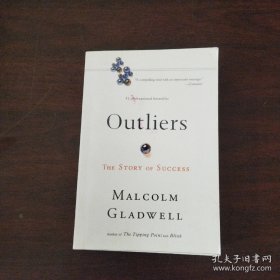
英文原版书 Outliers: The Story of Success 异类
书籍内容简介可联系客服查阅,查书找书开票同样可以联系客服
¥ 48 ¥ 48 九五品
库存70件
作者Malcolm Gladwell
出版社PRH 企鹅兰登
ISBN9780141043029
出版时间2023-06
装帧其他
定价48元
货号YB-1145
上书时间2024-08-24
- 最新上架
商品详情
- 品相描述:九五品
- 商品描述
-
内容摘要
依据《出版管理条例》,本书个别条目解释与中国实际情况不符,已做适当处理,但不影响任何整体阅读。此属正常情况,请事先知悉,以免给您带来不便。特此说明!!! 书名:Outliers 异类:不一样的成功启示录 作者:Malcolm Gladwell马尔科姆·格拉德威尔 出版社名称:Penguin 出版时间:2009 语种: 英文 ISBN:9780141043029 商品尺寸:13.1 x 2.3 x 18.1 cm 包装:平装 页数:365 (以实物为准) 成功的规律并非无迹可寻,甚至它并非如我们所想。Outliers《异类:不一样的成功启示录》,《纽约客》怪才马尔科姆·格拉德威尔(Malcolm Gladwell)关于成功的奇谈怪论,不可思议却又无比真实! 推荐理由: 1.马尔科姆·格拉德威尔,《纽约客》怪才传奇作者,被《时代》周刊评为全球有影响力的100位人物之一; 2.罗永浩、张瑞敏、李开复、俞敏洪、潘石屹、雷军等联袂推荐; 3. 英文原版,内容无删减,纸质护眼。 精彩书评 “格拉德威尔以精彩的笔墨,给出了一个简单的关于成功的等式:才智+社会环境+机遇+勤奋=成功。而我们过去常忽略的,便是其中非常重要的两项:社会环境与机遇。”——李开复 “在创新的路上,我们更需要探寻成功背后的真正原因,格拉德威尔笔下的《异类》无疑能给失意的人带来勇气,给得意的人带来启迪。中国每个有梦想的年轻人都应该读一读这本书。”——徐小平 “如果说只要掌握了取得成功的规律,我们就能创造出缤纷多彩的人生,那么,格拉德威尔的这本《异类》告诉我们的,便是成功的规律发挥作用的前提条件:一个人如果不能正视自己周围的环境,不能把握好每一份机遇,即便再有才华,也难以取得成功。”——唐骏 Why do some people achieve so much more than others? Can they lie so far out of the ordinary? Malcolm Gladwell looks at everyone from rock stars to scientific geniuses to show that the story of success is far more surprising, and inspiring, than we ever imagined. Review “Malcolm Gladwell ... has a genius for making everything he writes seem like an impossible adventure”—Tim Adams,Observer “The best kind of writer - the kind who makes you feel like you’re a genius, rather than he’s a genius”— Dominic Maxwell,The Times “I wanted to cheer or clap”— William Leith,Evening Standard “Fizzingly entertaining and enlightening”— Harry Ritchie,Daily Mail Outliers《异类》带我们走进了成功人士的世界,意外揭开一连串令人惊异的统计结果:英超联赛大多数球员都在9月至11月出生;比尔·盖茨和史蒂夫·乔布斯都生于1955年;纽约很多著名律所的开创者竟都是犹太人后裔,并且其祖辈大多在纽约服装行业谋生。为什么会出现这种情况?原因在于:英超球员的注册时间是每年9月,在同龄球员中,9月出生的人实际上比8月出生的人几乎大了一岁,一岁之差对他们的职业生涯影响巨大;1955年前后正是计算机革命时期,出生太早,无法拥有个人电脑,而出生太晚,计算机革命的时机又被别人占去……因此,那些奇才异类得感谢机遇的眷顾。另外,他们的成功还需要上辈人的文化熏陶,与文化传承息息相关:中国人的数学优势得益于中国人种植水稻的勤劳精神和汉字读音的简洁明了;20世纪90年代初韩国较高的飞机失事率,也是由韩国上下级之间过于严格的等级制度造成的。 怪才格拉德威尔告诉我们,如果没有机遇和文化、环境因素,即便是智商超过爱因斯坦,也只能做一份平庸的工作。《异类》带领我们找到了成功的根源,发现了更深刻的成功契机,也为社会变革带来新的启示。 Malcolm Gladwell shows why the story of success is far more surprising, and more fascinating, than we could ever imagine why are people successful? For centuries, humankind has grappled with this question, searching for the secret to accomplishing great things. In this stunning new book, Malcolm Gladwell takes us on an invigorating intellectual journey to show us what makes an extreme overachiever. He reveals that we pay far too much attention to what successful people are like, and too little attention to where successful people are from: their culture, their family, and their generation. Gladwell examines how the careers of Bill Gates and the performance of world-class football players are alike; what top fighter pilots and The Beatles have in common; why so many top lawyers are Jewish; why Asians are good at maths; and why it is correct to say that the mathematician who solved Fermat’s Theorem is not a genius. Just as he did in Blink, Gladwell overturns many of our conventional notions and creates an entirely new model for seeing the world. Brilliant and entertaining, this is a landmark work that will simultaneously delight and illuminate. 马尔科姆·格拉德威尔(Malcolm Gladwell),出生于英格兰,成长于加拿大,是一个有着牙买加血统的美国人,《纽约客》的怪才作家,被《时代》杂志评为“全球有影响力的100位人物之一”,《快公司》称其为“21世纪的彼得·德鲁克”。他于2011年6月获得加拿大高荣誉“加拿大勋章”。 在他的写作中,融合了科学、社会学及流行文化,并通过原创、清新、有趣的故事来呈现,格拉德威尔是这一写作风格的领军人物。迄今为止,格拉德威尔一共著有4本书,且都是《纽约时报》冠军图书。其作品《引爆点》和《异类》一度创造了书市神话,其中《引爆点》连续28周雄踞《纽约时报》畅销书榜首。他的新图书作品是《小狗看世界》。 因其观点新颖、思想前卫,《纽约时报》把格拉德威尔对社会思潮的影响称为“格拉德威尔效应”(Gladwell Effect)。 Author, journalist, and cultural commentatorMalcolm Gladwellwas born in 1963. He has worked for the Washinton Post and the New Yorker. His bestseller, The Tipping Point captured the world’s attention with its theory that a curiously small change can have unforeseen effects, and the phrase has become part of our language, used by writers, politicians and business people everywhere to describe cultural trends and strange phenomena. INTRODUCTION The Roseto Mystery PART ONE: OPPORTUNITY ONE The Matthew Effect TWO The 10000-Hour Rule THREE The Trouble with Geniuses, Part 1 FOUR The Trouble with Geniuses, Part 2 FIVE The Three Lessons of Joe Flom PART TWO: LEGACY SIX Harlan,Kentucky SEVEN The Ethnic Theory of Plane Crashes EIGHT Rice Paddies and Math Tests NINE Marita’s Bartgain EPILOGUE A Jamaical Story Notes Acknowledgments Index Roseto Valfortore lies one hundred miles southeast of Rome, in the Apennine foothills of the Italian province of Foggia. In the style of medieval villages, the town is organized around a large central square. Facing the square is the Palazzo Marchesale, the palace of the Saggese family, once the great landowner of those parts. An archway to one side leads to a church, the Madonna del Carmine — Our Lady of Mount Carmine. Narrow stone steps run up the hillside, flanked by closely-clustered two-story stone houses with red tile roofs. For centuries, the paesani of Roseto worked in the marble quarries in the surrounding hills, or cultivated the fields in the terraced valley below, walking four and five miles down the mountain in the morning and then making the long journey back up the hill at night. It was a hard life. The townsfolk were barely literate and desperately poor and without much hope for economic betterment — until word reached Roseto at the end of the nineteenth century of the land of opportunity across the ocean. In January of 1882, a group of eleven Rosetans — ten men and one boy — set sail for New York. They spent their first night in America sleeping on the floor of a tavern on Mulberry Street, in Manhattan’s Little Italy. Then they ventured west, ending up finding jobs in a slate quarry ninety miles west of the city in Bangor, Pennsylvania. The following year, fifteen Rosetans left Italy for America, and several members of that group ended up in Bangor as well, joining their compatriots in the slate quarry. Those immigrants, in turn, sent word back to Roseto about the promise of the New World, and soon one group of Rosetans after another packed up their bags and headed for Pennsylvania, until the initial stream of immigrants became a flood. In 1894 alone, some twelve hundred Rosetans applied for passports to America, leaving entire streets of their old village abandoned. The Rosetans began buying land on a rocky hillside, connected to Bangor only by a steep, rutted wagon path. They built closely clustered two story stone houses, with slate roofs, on narrow streets running up and down the hillside. They built a church and called it Our Lady of Mount Carmel, and named the main street on which it stood Garibaldi Avenue, after the great hero of Italian unification. In the beginning, they called their town New Italy. But they soon changed it to something that seemed more appropriate, given that in the previous decade almost all of them had come from the same village in Italy. They called it Roseto. In 1896, a dynamic young priest — Father Pasquale de Nisco — took over at Our Lady of Mount Carmel. De Nisco set up spiritual societies and organized festivals. He encouraged the townsfolk to clear the land, and plant onions, beans, potatoes, melons and fruit trees in the long backyards behind their houses. He gave out seeds and bulbs. The town came to life. The Rosetans began raising pigs in their backyard, and growing grapes for homemade wine. Schools, a park, a convent and a cemetery were built. Small shops and bakeries and restaurants and bars opened along Garibaldi Avenue. More than a dozen factories sprang up, making blouses for the garment trade. Neighboring Bangor was largely Welsh and English, and the next town over was overwhelmingly German, which meant — given the fractious relationships between the English and Germans and Italians, in those years — that Roseto stayed strictly for Rosetans: if you wandered up and down the streets of Roseto in Pennsylvania, in the first few decades after 1900, you would have heard only Italian spoken, and not just any Italian but the precise southern, Foggian dialect spoken back in the Italian Roseto. Roseto Pennsylvania was its own tiny, self-sufficient world — all but unknown by the society around it — and may well have remained so but for a man named Stewart Wolf. 1234567
相关推荐
-

Outliers异类 英文原版
八五品深圳
¥ 15.00
-

Outliers异类 英文原版
九品北京
¥ 25.00
-

OUTLIERS 异类 英文原版
九品北京
¥ 25.00
-

Outliers异类 英文原版
八五品东莞
¥ 58.00
-

Outliers异类 英文原版
八五品东莞
¥ 58.00
-

Outliers:The Story of Success ( 英文原版 )
九品北京
¥ 15.00
-

Outliers:The Story of Success(英文原版)
九品上海
¥ 30.00
-

Outliers: The Story of Success【英文原版】
九品晋中
¥ 27.00
-

Outliers:The Story of Success英文原版精装
九品广州
¥ 119.00
-

英文原版:INSIDERS AND OUTLIERS The Individual in History
九五品上海
¥ 268.00
— 没有更多了 —












以下为对购买帮助不大的评价